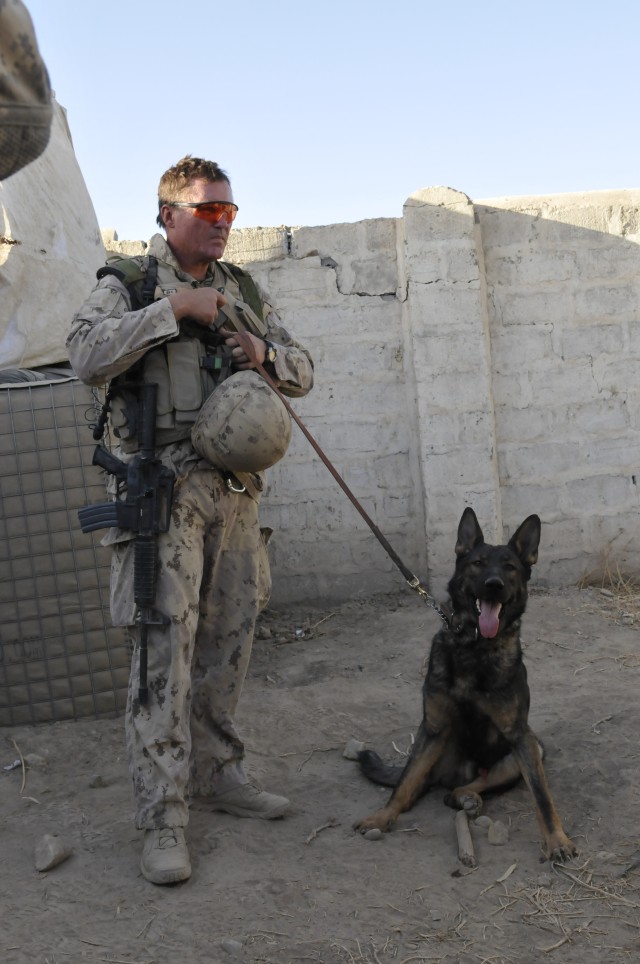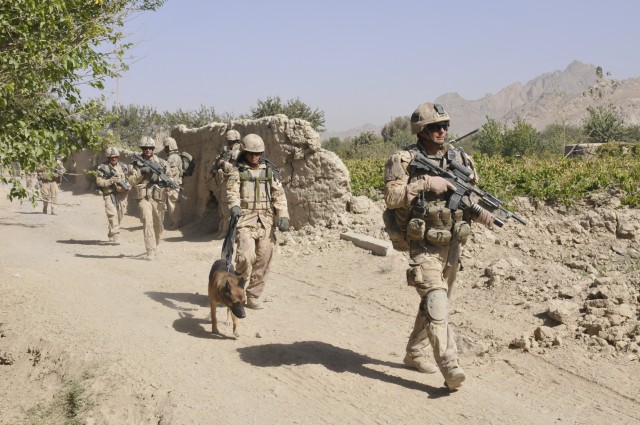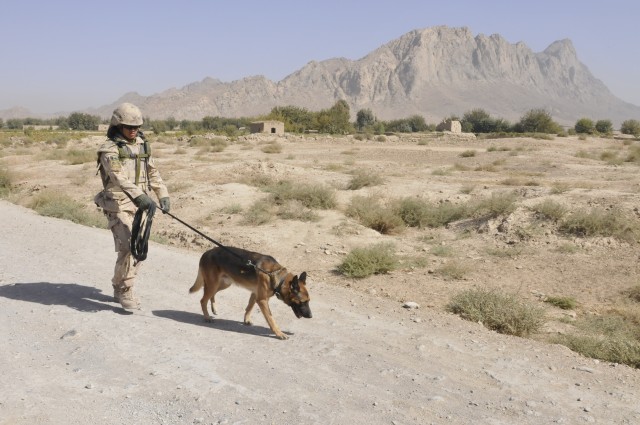MA'SUM GHAR, Afghanistan - The sun hasn't risen yet as an Explosive Detector Dog (EDD) team of American K-9 Detection Services (AMK9) prepares to lead a dismounted patrol through Panjwai'i District in Kandahar province Oct. 8. The partnered dismounted patrol leaving Combat Outpost Nejat consists of Afghan National Army soldiers, Afghan National Police and Canadian forces of the 1st Battalion, The Royal Canadian Regiment Battle Group.
To counter the growing Improvised Explosive Device (IED) threat in Afghanistan, the increased use of EDDs have become a critical part of daily operations. The EDDs consequently save the lives of both civilian and military personnel.
EDDs patrol military installations, take part in dismounted patrols, work at vehicle checkpoints, assist cordon and search missions and help find buried explosive devices.
Ambar Limbu, a Panchkhal, Nepal, native is part of a four-man team of dog handlers working with Canadian forces in Afghanistan. Limbu has a military background, having served in the Nepalese army for five years.
"We have worked together for almost three years," said Limbu of his German Shepherd, Tinus. This is their first tour together in Afghanistan.
Limbu said their mission is to find explosive devices, to assist in dismounted patrols and to work together with Canadian and American forces at numerous vehicle check points.
Of the many missions Limbu and Tinus have taken part in, one stands out in particular. They were on a dismounted patrol with Canadian forces on a regular cordon and search mission. While inside an abandoned house, Tinus found two large mortars, thus prompting the Canadian forces to call the Explosive Ordnance Disposal unit.
By finding the two mortars, Tinus saved many lives that day, Limbu said.
For another AMK9 EDD team the experience in Afghanistan is the same but different.
Andre LeRoux, a Victoria, South Africa, native and his German Shepherd, Sonny, have worked together for about five months. Prior to deploying to Afghanistan, they received pre-deployment training in San Antonio.
LeRoux and Sonny go on occasional mounted patrols, but Sonny prefers dismounted patrols.
"Dogs don't really like to be cramped. Sitting in a TLAV [Tracked Light Armored Vehicle] is a bit uncomfortable for them," said LeRoux. "Sonny especially, because he is a big dog."
LeRoux's and Sonny's primary roles are dismounted patrols as well as choke points. They patrol with both Canadian and American forces and normally conduct two missions a day about every four days.
"Sonny and I would go out in front and actually lead the patrol, especially on main roads where they bury IEDs. The dog goes five to ten meters left and right ahead of everyone else, making it safe for coalition forces to work," said LeRoux. "The more environments and scenarios a canine is presented, the better it will be able to perform. It sharpens their skills."
Not only does Sonny save lives; but another benefit of having him as a partner is that he works for a cheap salary.
LeRoux said Sonny gets to play with a blue squeaky ball whenever he finds something.
"You and I work for a salary; he works for the ball," said LeRoux, who says he enjoys what he does in Afghanistan.
"It's a great feeling, at the end of the day. It's something I enjoy, especially when we find IEDs," said LeRoux. "When you find a land mine, you know that it's one less mine to step on, the same with IEDs."
Another successful dismounted patrol complete as Limbu and Tinus return to COP Nejat. After walking through many compounds, various pomegranate groves and climbing over mud walls all morning, not one IED was found.
Limbu said he gets homesick sometimes, but "it feels great knowing you have made a difference."








Social Sharing